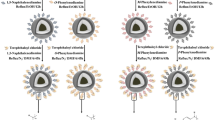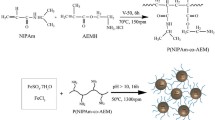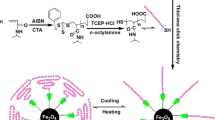Abstract
In this work, Fe3O4 particles were first prepared by a reversed microemulsion method, and then the prepared nanoparticles were modified with 3-(trimethoxysilyl) propyl methacrylate (KH-570), a silane coupling agent, to enhance the dispersibility and biocompatibility of Fe3O4 particles. To get the graft ratio quantitatively, and further achieve the maximum loading capacity of KH-570, the characterization method for the graft ratio (Gr) was systemically explored first; reformative silicon molybdenum chromogenic (RSMC) was designed and presented a good result. In addition, the influence of operation conditions on the graft ratio was investigated and optimized. Results showed the graft ratio of KH-570 on magnetic Fe3O4 nanoparticles arrived at 178.51% under optimal conditions. In addition, it displayed KH-570 grafted onto the surface of Fe3O4 nanoparticles successfully, and only one silicon hydroxyl was bonded on the surface of Fe3O4 nanoparticles under optimal modifications. Finally, a magnetic composite carrier was prepared by grafting glycidyl methacrylate (GMA) onto the surface of the modified nanoparticles. Further, the composite was used to immobilize penicillin G acylase (PGA); in addition, the effect of GMA dosage on enzyme activity (EA), enzyme activity recovery rate (EAR), and enzyme loading rate (ELR) was studied. It was found that when the amount of GMA was 9.0%, the EA, EAR, and ELR were 9208 U/g, 88 mg/g, and 64.08%, respectively. In addition, the immobilized PGA still possess superparamagnetism, which can be well recycled and reused.

Graphical abstract













Similar content being viewed by others
References
Cheng Z, Wang A, Wang H, Du Z, Zhu S, Yang M, Zhang S, Shubao S, 周成, 王安明, 王华 (2008) Progress in immobilization and application of penicillin acylase. Chin J Antibiot 33:257–264
Kallenberg AI, van Rantwijk F, Sheldon RA (2005) Immobilization of penicillin G acylase: the key to optimum performance. Adv Synth Catal 347:905–926
Xiao QG, Xia T, Chen JF (2007) Silica nanotubes based on needle-like calcium carbonate: fabrication and immobilization for glucose oxidase. Ind Eng Chem Res 46:459–463
Gao L, Jin L (2016) Research advances on the immobilization of penicillin G acylase. Bulletin of Fermentation Science & Technology 45:55-60
Lin Z, Zhen L, Xu L, Yang G, Zhang X, Cheng ZY (2016) Nano-clip based composites with a low percolation threshold and high dielectric constant. Nano Energy 26:S221128551630204X
Liu Z, Zhang L, Wang R, Poyraz S, Cook J, Bozack MJ, Das S, Zhang X, Hu L (2016) Ultrafast microwave nano-manufacturing of fullerene-like metal chalcogenides. Sci Rep 6:22503
Zhang L, Du W, Nautiyal A, Liu Z, Zhang X (2018) Recent progress on nanostructured conducting polymers and composites: synthesis, application and future aspects. Science China Materials 61:303–352
Qu G, Cao X, Lei W, Ping X (2011) Immobilization and enzymological property of penicillin G acylase immobilized on the magnetic composite support. Journal of Ningxia University 32:57-61
Xiaogang L, Lina Z (2010) Immobilization of penicillin G acylase in epoxy-activated magnetic cellulose microspheres for improvement of biocatalytic stability and activities. Biomacromolecules 11:2896–2903
Wei H, Wang E (2013) Nanomaterials with enzyme-like characteristics (nanozymes): next-generation artificial enzymes. Chem Soc Rev 44:6060–6093
Tay CY, Setyawati MI, Xie J, Parak WJ, Leong DT (2015) Back to basics: exploiting the innate physico-chemical characteristics of nanomaterials for biomedical applications. Adv Funct Mater 24:5936–5955
Bhattacharjee A, Basu A, Ghosh P, Biswas J, Bhattacharya S (2014) Protective effect of selenium nanoparticle against cyclophosphamide induced hepatotoxicity and genotoxicity in Swiss albino mice. J Biomater Appl 29:303–317
Sayem Mozumder M, Zhu J, Perinpanayagam H (2011) Nano-TiO 2 enriched polymeric powder coatings support human mesenchymal cell attachment and growth. J Biomater Appl 26:173–193
Khaled SMZ, Charpentier PA, Rizkalla AS (2010) Physical and mechanical properties of PMMA bone cement reinforced with nano-sized titania fibers. J Biomater Appl 25:515–537
Zhu M, Chen Q, Tong W, Kan J, Sheng W (2017) Preparation and application of Fe_3O_4 nanomaterials. Progress in Chemistry 11:1366-1394
Yan W, Guo J, Xiang C, Kangwei MO, Zushun XU (2017) Research on magnetic iron oxide nanoparticles for theranostics. Journal of Hubei University 39:317-322+328
Dong CF, Liu SH, Liu CX (2017) Research progress in preparation and application of environment-responsive chitosan nanomaterial. Journal of Cangzhou Normal University 33:49-52+57
Nam KC, Choi KH, Lee KD, Kim JH, Jung JS, Park BJ (2016) Particle size dependent photodynamic anticancer activity of hematoporphyrin-conjugated Fe 3 O 4 particles. J Nanomater 2016:1–9
Prusakov VE, Maksimov YV, Nishchev KN, Golub’Ev AV, Beglov VI, Krupyanskii YF, Bychkova AV, Iordanskii AL, Berlin AA (2018) Hybrid biodegradable nanocomposites based on a biopolyester matrix and magnetic iron oxide nanoparticles: structural, magnetic, and electronic characteristics. Russian Journal of Physical Chemistry B 12:158–164
Gutsev GL, Belay KG, Gutsev LG, Ramachandran BR, Jena P (2018) Effect of hydrogenation on the structure and magnetic properties of an iron oxide cluster. Phys Chem Chem Phys 20:4546
Sangaiya P, Jayaprakash R (2018) Tuning effect of Sn doping on structural, morphological, optical, electrical and photocatalytic properties of iron oxide nanoparticles. Mater Sci Semicond Process 85:40–51
Liu TT, Chen L, Min NI, Hai-Dong GU, Zhang ZE (2017) Research progress on iron oxide and its composite materials for li-ion battery. Chinese Battery Industry 21:44-50
Jung KW, Choi BH, Jeong TU, Ahn KH (2016) Facile synthesis of magnetic biochar/Fe3O4 nanocomposites using electro-magnetization technique and its application on the removal of acid orange 7 from aqueous media. Bioresour Technol 220:672–676
Jia Y, Gao Z, Cui J (2017) Preparation and characterization of two different amino-modified iron oxide magnetic nanoparticles and determination of the amount of amino on nanoparticle surface. Journal of Preventive Medicine of Chinese Peoples Liberation Army 35:1-5
Zhao S, Gong H, Yu X, Xin Z, Sun S, Zhou S, Shi Y (2016) A highly active and selective β-nucleating agent for isotactic polypropylene and crystallization behavior of β-nucleated isotactic polypropylene under rapid cooling. J Appl Polym Sci 133:1993
Yang Q, Fengyan LI, Qiu F, Liu Y, Textiles SO, T.P. University (2016) Preparation and characterization of Fe_3O_4 nano particles with oxygen. Journal of Textile Research 37:7-11
Wang M, Fei X, Lv S, Sheng Y, Zou H, Song Y, Yan F, Zhu Q, Zheng K (2018) Synthesis and characterization of a flexible fluorescent magnetic Fe3O4@SiO2/CdTe-NH2 nanoprobe. J Inorg Biochem 186:307
Yin NQ, Wu P, Yang TH, Wang M (2017) Preparation and study of a mesoporous silica-coated Fe3O4 photothermal nanoprobe. RSC Adv 7:9123–9129
Liu SH, Miao CL, Wang YJ, Shao BQ, Liu FF, Xing RM (2011) Preparation of octahedral nanostructured ferroferric oxide via solvothermal route. Chem Res
Guan CY, Hou SD, Zhou Y, Zeng RS (2016) Biocompatibility of magnetic ferrosoferric oxide nanoparticles in preosteoblasts. CJTER 20:5684-5690
Zhou S, Lin C (2009) Preparation of magnetic Fe_3O_4 nano-particles via reverse microemulsion. Journal of Fujian Medical University 43:148-152
Patsula V, Kosinova L, Lovric M, Ferhatovic L, Rabyk M, Konefal R, Paruzel A, Slouf M, Herynek V, Gajovic S (2016) Superparamagnetic Fe3O4 nanoparticles: synthesis by thermal decomposition of iron(III) glucuronate and application in magnetic resonance imaging. ACS Appl Mater Interfaces 8:7238
Wen D, Liu ML, Qiang-Lin LI (2011) Preparation and characterization of super-paramagnetic Fe_3O_4 nanoparticles. Journal of Sichuan Normal University 34:385–387
Xiao-Ming FU, Sun H (2016) New method of Fe_3O_4 nanoparticles prepared through the thermal decomposition of FeC_2O_4·2H_2O in the argon gas. Science Technology & Engineering 16:191-194
Mahmoodi NM (2015) Surface modification of magnetic nanoparticle and dye removal from ternary systems. J Ind Eng Chem 27:251–259
Yao C, Gao GS, Lin XP, Yang XJ, Lu LD, Wang X (2006) Surface modification of nanosized TiO2 with silane coupling reagent. J Inorg Mater 21:315–321
Ding M, Xiao Y (2017) Research progress on preparation and properties of Fe_3O_4 and its composite nano materials. Guangdong Chemical Industry 44:129-131
Sajadi SM, Nasrollahzadeh M, Maham M (2016) Aqueous extract from seeds of Silybum marianum L. as a green material for preparation of the Cu/Fe3O4 nanoparticles: a magnetically recoverable and reusable catalyst for the reduction of nitroarenes. J Colloid Interface Sci 469:93
Liu X, Kaminski MD, Guan Y, Chen H, Liu H, Rosengart AJ (2006) Preparation and characterization of hydrophobic superparamagnetic magnetite gel. J Magn Magn Mater 306:248–253
Lai BH, Yeh CC, Chen DH (2012) Surface modification of iron oxide nanoparticles with polyarginine as a highly positively charged magnetic nano-adsorbent for fast and effective recovery of acid proteins. Process Biochem 47:799–805
Guan Y, Jiang B, Zhu X, Liu H (2000) Recent developments of magnetic separation in biotechnology(I) preparation of magnetic carriers and surface chemical modification. Energy Chemical Industry S1:315-319
Chen K, Zhao Y, Yuan X (2013) Chemical modification of silica: method, mechanism, and application. Progr Chem 25:95–104
Li S, Duan FF, Yang YZ, Liu XG, Xu BS (2011) Surface modification of carbon microspheres using a silane coupling agent. J Funct Mater 42:25–29
Lijing YE, Xin F, Wang H, Zhong Y, Qiang X, Zhi Z, Yun S, Ping W (2013) Effect of surface modification with silane coupling agent on enhancing pzc value and enzyme loading capacity of mesoporous TiO_2 whiskers. Ciesc J 64:2160–2168
Yuan Y, Xue C, Wang H, Zhang Q (2011) Research on optical fiber sensor based on nanoparticles-modified. In: International Conference on Electronics and Optoelectronics, pp V2–314–V312–316
Chen L, Jing Y (2013) Surface modification of nano γ-ferric oxide with silane coupling agent KH-550. Paper Chemicals 25:19-22
Wang Y, Chen G, Yue C, Zhao Y, Zijian HE (2015) Mechanism of nano-TiO_2 modified silane coupling agent and grafting acrylonitrile. Chem Ind & Eng Pro 34:3985-3989
Wang J, Li J, Guo G, Wang Q, Tang J, Zhao Y, Qin H, Tuerhongjiang W, Shen H, Liu X (2016) Silver-nanoparticles-modified biomaterial surface resistant tostaphylococcus: new insight into the antimicrobial action of silver. Sci Rep 6:32699
Chen SR, Wan Xing QU, Ka Qiu XU (2003) Application of silane coupling agent. Silicone Material 17:28-31
Yoshihara K, Nagaoka N, Sonoda A, Maruo Y, Makita Y, Okihara T, Irie M, Yoshida Y, Van MB (2016) Effectiveness and stability of silane coupling agent incorporated in ‘universal’ adhesives. Dent Mater 32:1218-1225
Elshereksi NW, Ghazali MJ, Muchtar A, Che HA (2017) Studies on the effects of titanate and silane coupling agents on the performance of poly (methyl methacrylate)/barium titanate denture base nanocomposites. J Dent 56:121–132
Kang L, Yang LI, Xing YQ, Hui YU (2015) Investigation of optimum conditions for silicon dioxide determination in water by silico-molybdenum blue spectrophotometry. Journal of Beijing Institute of Petro-Chemical Technology 23:5-10
Dekker A, Reitsma K, Beugeling T, Bantjes A, Feijen J, Kirkpatrick CJ, Aken WGV (2017) Surface modification of hydrophobic polymers for improvement of endothelial cell—surface interactions. Clin Mater 11:157–162
Guo L (2013) Silicon molybdenum blue spectrophotometric method was used for determination of the content of silica in iron powder. Science & Technology Innovation Herald 03:12
Liu HY, De-Ling LI, Xing LI (2011) Surface modification of nano-silica by silane coupling agent KH-560. Chem World 52:456–864
Wang Y, Zhang Y, Xiaodong HE (2003) Improvement of silica determination in alumina with spectrophotometr of silica-molybdenum. Nonferrous Metals Engineering 03:147-148
Vescovi V, Kopp W, Guisán JM, Giordano RLC, Mendes AA, Tardioli PW (2016) Improved catalytic properties of Candida antarctica lipase B multi-attached on tailor-made hydrophobic silica containing octyl and multifunctional amino- glutaraldehyde spacer arms. Process Biochem 51:2055-2060
Liu B, Zhang W, Yang F, Feng H, Yang X (2011) Facile method for synthesis of Fe3O4@polymer microspheres and their application as magnetic support for loading metal nanoparticles. J Phys Chem C 115:15875–15884
Hua Q, Lai Y, Niu D, Sun S (2013) Surface-enhanced Raman scattering from magneto-metal nanoparticle assemblies. Anal Chim Acta 763:38–42
Li J, Wang L, Benicewicz BC (2013) Synthesis of Janus nanoparticles via a combination of the reversible click reaction and “grafting to” strategies. Langmuir 29:11547-11553
Yildirim E, Turan E, Caykara T (2011) Construction of myoglobin imprinted polymer films by grafting from silicon surface. J Mater Chem 22:636–642
Norris BC, Sheppard DG, Henkelman G, Bielawski CW (2011) Kinetic and thermodynamic evaluation of the reversible N-heterocyclic carbene−isothiocyanate coupling reaction: applications in latent catalysis. J Organomet Chem 76:301–304
Shuang W, Qian W, Heng-Song JI, Jiang XM (2013) Experimental study of the quick pyrolysis of Enteromorpha Clathrata to prepare bio-oil under various conditions. Journal of Engineering for Thermal Energy & Power 28:202–206
Ishibashi T, Sato B, Rikitake M, Seo T, Kurokawa R, Hara Y, Naritomi Y, Hara H, Nagao T (2012) Consumption of water containing a high concentration of molecular hydrogen reduces oxidative stress and disease activity in patients with rheumatoid arthritis: an open-label pilot study. Med Gas Res 2:1–8
Funding
This work was supported by National Natural Science Foundation of China (Grant No. 51563015).
Author information
Authors and Affiliations
Corresponding authors
Ethics declarations
Conflict of interest
The authors declare that they have no conflict of interest.
Additional information
Publisher’s note
Springer Nature remains neutral with regard to jurisdictional claims in published maps and institutional affiliations.
Rights and permissions
About this article
Cite this article
Zhang, X., Chen, Z., Li, K. et al. Immobilization of penicillin G acylase on a novel paramagnetic composite carrier with epoxy groups. Adv Compos Hybrid Mater 2, 720–734 (2019). https://doi.org/10.1007/s42114-019-00099-3
Received:
Revised:
Accepted:
Published:
Issue Date:
DOI: https://doi.org/10.1007/s42114-019-00099-3




